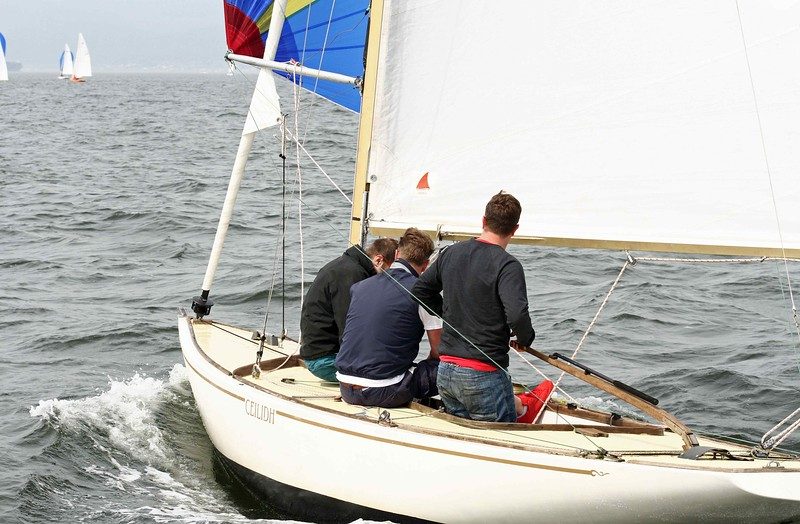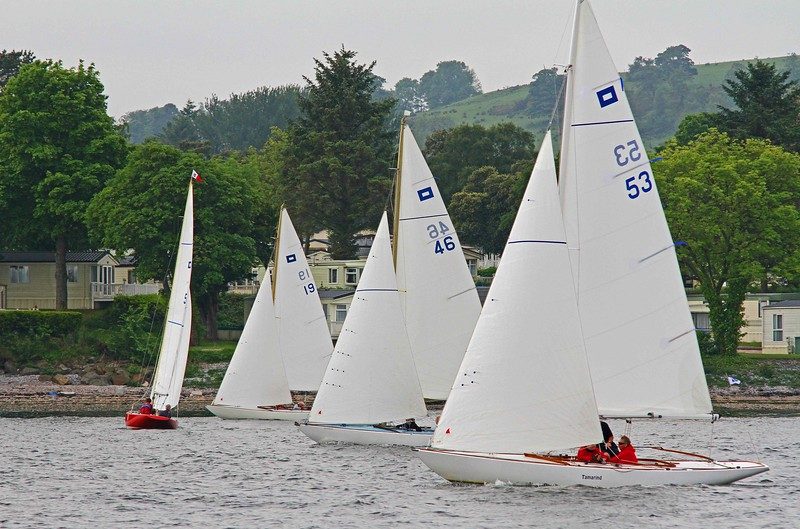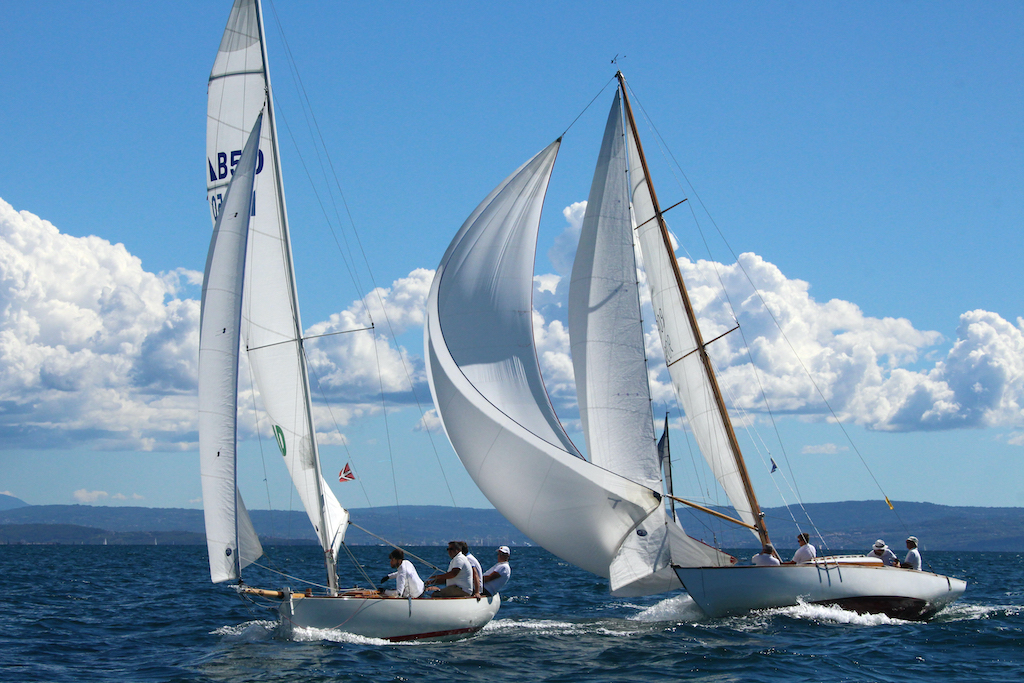
THE STORY OF THE PIPER CLASS
By Bob Donaldson (courtesy of The Piper Owners’ Association: http://www.piper-od.co.uk/)
The Piper was designed by David Boyd at Sandbank in 1965/66 and was based on Sovereign, the British 12 metre challenger for the Americas Cup in 1964, also designed by Boyd and built by Robertson’s of Sandbank on the Clyde. A prototype for the class, “Sandpiper” was built in wood at the beginning of 1966 and competed in Clyde Week that summer.
Although the GRP Pipers, (which were produced from moulds taken from “Sandpiper” and plugs made in Sandbank), were finished by Robertson’s, the GRP hulls and decks for the first 14 boats were built by Marine Plastics at Grimsby, although, as a concession to superstition, No. 13 was never built. The moulding’s were then transported to Scotland for finishing, fitting out and rigging. Subsequently the moulding’s for Pipers No. 16-46 were constructed by Halmatic on the Solent from 1969 to 1972 before Robertson’s established their own GRP facility in 1973 and began construction of the entire boats.

A combination of failure by Robertson’s to adapt successfully to production line building after decades of creating bespoke one-off yachts and the massive layup of glass-fibre in the hulls required by the class rules gradually priced the Piper Class out of the market as modern lightweight classes such as the Soling and Etchells 22 took over, although these building techniques did result in the Piper being almost indestructible. The oldest boats can and do compete on equal terms with the latest boats built, and a Piper’s lifespan has still to be determined.
Only 13 complete boats were constructed at Sandbank before construction at Sandbank ceased with no. 58, “Hee Hoo” when Robertson’s then transferred production to the American designed E-22 and commercial pilot and harbour launches, but even then the writing was on the wall financially and when the yard closed down in the early 1980s the two sets of Piper moulds were burnt during the clear up, and with that any further development of the class in Scotland ended.

At this time, however, the Pipers were one of the main racing classes on the Clyde with an average of 18 boats competing regularly each weekend from the Royal Northern Yacht Club at Rhu, the Royal Gourock Yacht Club and the Holy Loch sailing Club at Sandbank. During their unofficial Class Championships during Clyde Week in early July well over 20 boats competed at the highest level for the Ferrier Rose Bowl.
Gradually, with different life patterns and demand for free time, these numbers decreased as racing on the Clyde generally diminished but when the Owners Association decided in 1993 to hold an annual championship, initially over three weekends racing and then over one weekend at Gourock, numbers of competing boats began to increase and at the 30th Anniversary Regatta, held at the Holy Loch Sailing Club in 1996, 22 yachts took part.
Since then racing has continued at the three main venues, and particularly at the class’s traditional base at Sandbank, where 14 boats sail, although more recently there has been a resurgence of enthusiasm of interest at Gourock where the demise of the Loch Longs has been the Piper’s gain. In addition to the Clyde fleets, several boats have also been exported to England, Greece, Bermuda, USA, Switzerland, Antigua and Nigeria where three boats were bought for social sailing for oil production workers. In 1998, when the managing director of Cornish Crabbers of Wadebridge in Devon spotted No .2 “Peter Piper” sitting at a pontoon in Plymouth Marina, he was so taken that he took a mould off No. 25 “Suzie Wong” and recommenced Piper production in the West Country. Only 5 or 6 boats were built by the company but the standard of construction of these is high and turned many heads at London and Southampton Boat Shows during their production.
More recently, the classic shape and style of the Piper has attracted interest across the Atlantic by a group of sailors in Antigua who had previously sailed six metres and International One Designs. Frustrated by the worldwide downturn of the economy and the constant difficulty in securing the services of skilled crewmen for their yachts, they sent a naval architect and boat builder to Scotland to check out the Piper as a suitable replacement for their cumbersome and expensive classics. Class secretary Cushla Thoms was able to furnish him with drawings and information on the class and he reported home on his findings. The upshot was that “Cirrus”, Piper No.24 was purchased and transported to the Caribbean where she was used as a plug to construct another set of moulds with the intention of beginning production, before restoring “Cirrus” to immaculate condition and renaming her “Spring Tide”. She has sailed regularly and competed in the prestigious Antigua Week since 2005 among many other stately classics, and attracted much international recognition.

As yet, the “Caribbean moulds” have not been used in anger to create a West Indian Piper, but the hope is still that local owners on the Clyde will sometime be able to pack a blazer and toothbrush and travel to Antigua to enjoy their many social activities and whether while indulging in a spot of team racing with kindred spirits across the pond.
Meanwhile, Rustler Yachts in England have purchased the Cornish Crabber Piper moulds and are producing a re-vamped version named the Rustler 24 with the same hull shape but a more “contemporary” deck layout and rig. These “new Pipers” have been developed with the mini super-yacht in mind and the attraction of owning a classic yacht in miniature has created a niche in the burgeoning market for distinctive traditional day-boats.
On the downside, however, with Pipers being built in England and internationally at considerably high prices compared to the second hand cost of those on the Clyde, , several boats have been snapped up and removed to England along with “Suzie Wong” and “Cirrus”, “Kelpie”, “Sayonara”, Bramble and Pied Piper being the latest defectors. If the class is to remain intact on the Clyde, increased local enthusiasm and class loyalty will need to be maintained to prevent an exodus of these fine yachts, as has happened to the local Loch.
Click here for a list of the Piper Class.








